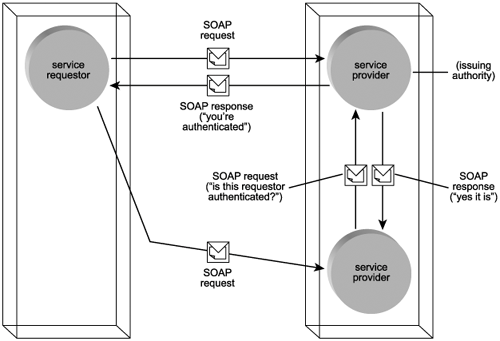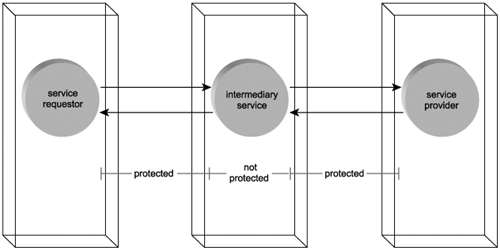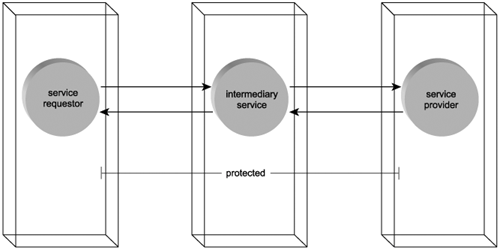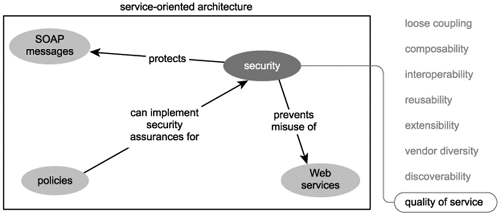Security
Security requirements for automation solutions are nothing new to the world of IT. Similarly, service-oriented applications need to be outfitted to handle many of the traditional security demands of protecting information and ensuring that access to logic is only granted to those permitted.
However, the SOAP messaging communications framework, upon which contemporary SOA is built, emphasizes particular aspects of security that need to be accommodated by a security framework designed specifically for Web services.
A family of security extensions parented by the WS-Security specification comprise such a framework, further broadened by a series of supplementary specifications with specialized feature sets. Sidebar 7.1 provides a list of current security-related specifications. While we clearly cannot discuss concepts for all of them, it is worth spending some time looking at the basic functions performed by the following three core specifications:
- WS-Security
- XML-Signature
- XML-Encryption
Additionally, we'll briefly explore the fundamental concepts behind single sign-on, a form of centralized security that complements these WS-Security extensions.
Before we begin, it is worth noting that this section organizes security concepts as they pertain to and support the following five common security requirements: identification, authentication, authorization, confidentiality, and integrity.
Note
For an overview of the core language elements from the WS-Security, XML-Encryption, and XML-Signature languages, see the WS-Security language basics section in Chapter 17.
7.6.1. Identification, authentication, and authorization
For a service requestor to access a secured service provider, it must first provide information that expresses its origin or owner. This is referred to as making a claim (Figure 7.27). Claims are represented by identification information stored in the SOAP header. WS-Security establishes a standardized header block that stores this information, at which point it is referred to as a token.
Figure 7.27. An identity is a claim made regarding the origin of a message.

Authentication requires that a message being delivered to a recipient prove that the message is in fact from the sender that it claims to be (Figure 7.28). In other words, the service must provide proof that its claimed identity is true.
Figure 7.28. Authentication means proving an identity.

Once authenticated, the recipient of a message may need to determine what the requestor is allowed to do. This is called authorization (Figure 7.29).
Figure 7.29. Authorization means determining to what extent authentication applies.

7.6.2. Single sign-on
A challenge facing the enablement of authentication and authorization within SOA is propagating the authentication and authorization information for a service requestor across multiple services behind the initial service provider. Because services are autonomous and independent from each other, a mechanism is required to persist the security context established after a requestor has been authenticated. Otherwise, the requestor would need to re-authenticate itself with every subsequent request.
The concept of single sign-on addresses this issue. The use of a single sign-on technology allows a service requestor to be authenticated once and then have its security context information shared with other services that the requestor may then access without further authentication.
There are three primary extensions that support the implementation of the single sign-on concept:
- SAML (Security Assertion Markup Language)
- .NET Passport
- XACML (XML Access Control Markup Language)
As an example of a single sign-on technology that supports centralized authentication and authorization, let's briefly discuss some fundamental concepts provided by SAML.
SAML implements a single sign-on system in which the point of contact for a service requestor can also act as an issuing authority. This permits the underlying logic of that service not only to authenticate and authorize the service requestor, but also to assure the other services that the service requestor has attained this level of clearance.
Other services that the service requestor contacts, therefore, do not need to perform authentication and authorization steps. Instead, upon receiving a request, they simply contact the issuing authority to ask for the authentication and authorization clearance it originally obtained. The issuing authority provides this information in the form of assertions that communicate the security details. (The two types of assertions that contain authentication and authorization information are simply called authentication assertions and authorization assertions.)
In Figure 7.30 we illustrate some of the mechanics behind SAML.
Figure 7.30. A basic message exchange demonstrating single sign-on (in this case, as implemented by SAML).

7.6.3. Confidentiality and integrity
Confidentiality is concerned with protecting the privacy of the message contents (Figure 7.31). A message is considered to have remained confidential if no service or agent in its message path not authorized to do so viewed its contents.
Figure 7.31. Confidentiality means that the privacy of the message has been protected throughout its message path.

Integrity ensures that a message has not been altered since its departure from the original sender (Figure 7.32). This guarantees that the state of the message contents remained intact from the time of transmission to the point of delivery.
Figure 7.32. Integrity means ensuring that a message's contents have not changed during transmission.

7.6.4. Transport-level security and message-level security
The type of technology used to protect a message determines the extent to which the message remains protected while making its way through its message path. Secure Sockets Layer (SSL), for example, is a very popular means of securing the HTTP channel upon which requests and responses are transmitted. However, within a Web services-based communications framework, it can only protect a message during the transmission between service endpoints. Hence, SSL only affords us transport-level security (Figure 7.33).
Figure 7.33. Transport-level security only protects the message during transit between service endpoints.

If, for example, a service intermediary takes possession of a message, it still may have the ability to alter its contents. To ensure that a message is fully protected along its entire message path, message-level security is required (Figure 7.34). In this case, security measures are applied to the message itself (not to the transport channel on which the message travels). Now, regardless of where the message may travel, the security measures applied go with it.
Figure 7.34. Message-level security guarantees end-to-end message protection.

7.6.5. Encryption and digital signatures
Message-level confidentiality for an XML-based messaging format, such as SOAP, can be realized through the use of specifications that comprise the WS-Security framework. In this section we focus on XML-Encryption and XML-Signature, two of the more important WS-Security extensions that provide security controls that ensure the confidentiality and integrity of a message.
XML-Encryption, an encryption technology designed for use with XML, is a cornerstone part of the WS-Security framework. It provides features with which encryption can be applied to an entire message or only to specific parts of the message (such as the password).
To ensure message integrity, a technology is required that is capable of verifying that the message received by a service is authentic in that it has not been altered in any manner since it first was sent. XML-Signature provides features that allow for an XML document to be accompanied by a special algorithm-driven piece of information that represents a digital signature. This signature is tied to the content of the document so that verification of the signature by the receiving service only will succeed if the content has remained unaltered since it first was sent.
Note
Digital signatures also support the concept of non-repudiation, which can prove that a message containing a (usually legally binding) document was sent by a specific requestor and delivered to a specific provider.
As illustrated in Figure 7.35, XML-Encryption can be applied to parts of a SOAP header, as well as the contents of the SOAP body. When signing a document, the XML-Signature can reside in the SOAP header.
Figure 7.35. A digitally signed SOAP message containing encrypted data.

Note
Both encryption and digital signature technologies rely on the use of keys. These are special values used to unlock the algorithm upon which encryption and digital signatures are based. Shared keys are typically used by encryption technologies and require that both the sender and receiver of a message use the same key. Public/private key pairs are commonly used by digital signature technologies, where the message sender signs the document with a key that is different from the one used by the recipient. (One of the keys is public, but the other is private.)
7.6.6. Security and SOA
Message-level security can clearly become a core component of service-oriented solutions. Security measures can be layered over any message transmissions to either protect the message content or the message recipient. The WS-Security framework and its accompanying specifications therefore fulfill fundamental QoS requirements that enable enterprises to:
- utilize service-oriented solutions for the processing of sensitive and private data
- restrict service access as required
As shown in Figure 7.36, the security framework provided by WS-Security also makes use of the WS-Policy framework explained earlier (a separate specification called WS-SecurityPolicy provides a series of supporting policy assertions).
Figure 7.36. Security, as it relates to policies, SOAP messages, and Web services.

|
SUMMARY OF KEY POINTS |
|---|
|
Introduction
- Why this book is important
- Objectives of this book
- Who this book is for
- What this book does not cover
- How this book is organized
- Additional information
Case Studies
- Case Studies
- How case studies are used
- Case #1 background: RailCo Ltd.
- Case #2 background: Transit Line Systems Inc.
Part I: SOA and Web Services Fundamentals
Introducing SOA
- Introducing SOA
- Fundamental SOA
- Common characteristics of contemporary SOA
- Common misperceptions about SOA
- Common tangible benefits of SOA
- Common pitfalls of adopting SOA
The Evolution of SOA
- The Evolution of SOA
- An SOA timeline (from XML to Web services to SOA)
- The continuing evolution of SOA (standards organizations and contributing vendors)
- The roots of SOA (comparing SOA to past architectures)
Web Services and Primitive SOA
- Web Services and Primitive SOA
- The Web services framework
- Services (as Web services)
- Service descriptions (with WSDL)
- Messaging (with SOAP)
Part II: SOA and WS-* Extensions
Web Services and Contemporary SOA (Part I: Activity Management and Composition)
- Web Services and Contemporary SOA (Part I: Activity Management and Composition)
- Message exchange patterns
- Service activity
- Coordination
- Atomic transactions
- Business activities
- Orchestration
- Choreography
Web Services and Contemporary SOA (Part II: Advanced Messaging, Metadata, and Security)
- Web Services and Contemporary SOA (Part II: Advanced Messaging, Metadata, and Security)
- Addressing
- Reliable messaging
- Correlation
- Policies
- Metadata exchange
- Security
- Notification and eventing
Part III: SOA and Service-Orientation
Principles of Service-Orientation
- Principles of Service-Orientation
- Service-orientation and the enterprise
- Anatomy of a service-oriented architecture
- Common principles of service-orientation
- How service-orientation principles inter-relate
- Service-orientation and object-orientation (Part II)
- Native Web service support for service-orientation principles
Service Layers
- Service Layers
- Service-orientation and contemporary SOA
- Service layer abstraction
- Application service layer
- Business service layer
- Orchestration service layer
- Agnostic services
- Service layer configuration scenarios
Part IV: Building SOA (Planning and Analysis)
SOA Delivery Strategies
- SOA Delivery Strategies
- SOA delivery lifecycle phases
- The top-down strategy
- The bottom-up strategy
- The agile strategy
Service-Oriented Analysis (Part I: Introduction)
- Service-Oriented Analysis (Part I: Introduction)
- Service-oriented architecture vs. Service-oriented environment
- Introduction to service-oriented analysis
- Benefits of a business-centric SOA
- Deriving business services
Service-Oriented Analysis (Part II: Service Modeling)
- Service-Oriented Analysis (Part II: Service Modeling)
- Service modeling (a step-by-step process)
- Service modeling guidelines
- Classifying service model logic
- Contrasting service modeling approaches (an example)
Part V: Building SOA (Technology and Design)
Service-Oriented Design (Part I: Introduction)
- Service-Oriented Design (Part I: Introduction)
- Introduction to service-oriented design
- WSDL-related XML Schema language basics
- WSDL language basics
- SOAP language basics
- Service interface design tools
Service-Oriented Design (Part II: SOA Composition Guidelines)
- Service-Oriented Design (Part II: SOA Composition Guidelines)
- Steps to composing SOA
- Considerations for choosing service layers
- Considerations for positioning core SOA standards
- Considerations for choosing SOA extensions
Service-Oriented Design (Part III: Service Design)
- Service-Oriented Design (Part III: Service Design)
- Service design overview
- Entity-centric business service design (a step-by-step process)
- Application service design (a step-by-step process)
- Task-centric business service design (a step-by-step process)
- Service design guidelines
Service-Oriented Design (Part IV: Business Process Design)
- Service-Oriented Design (Part IV: Business Process Design)
- WS-BPEL language basics
- WS-Coordination overview
- Service-oriented business process design (a step-by-step process)
Fundamental WS-* Extensions
- Fundamental WS-* Extensions
- You mustUnderstand this
- WS-Addressing language basics
- WS-ReliableMessaging language basics
- WS-Policy language basics
- WS-MetadataExchange language basics
- WS-Security language basics
SOA Platforms
Appendix A. Case Studies: Conclusion
EAN: 2147483647
Pages: 150
